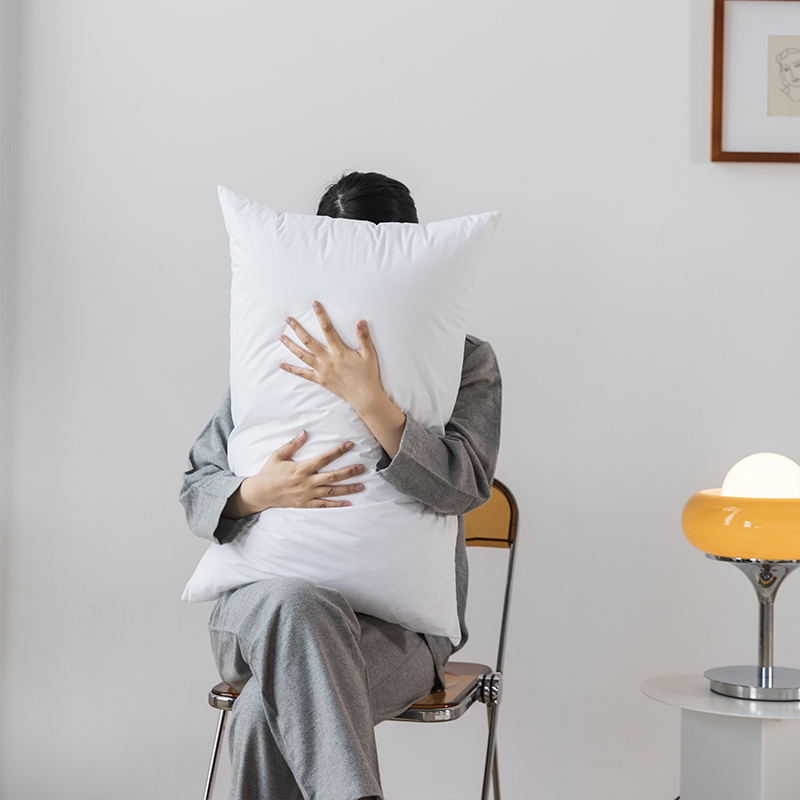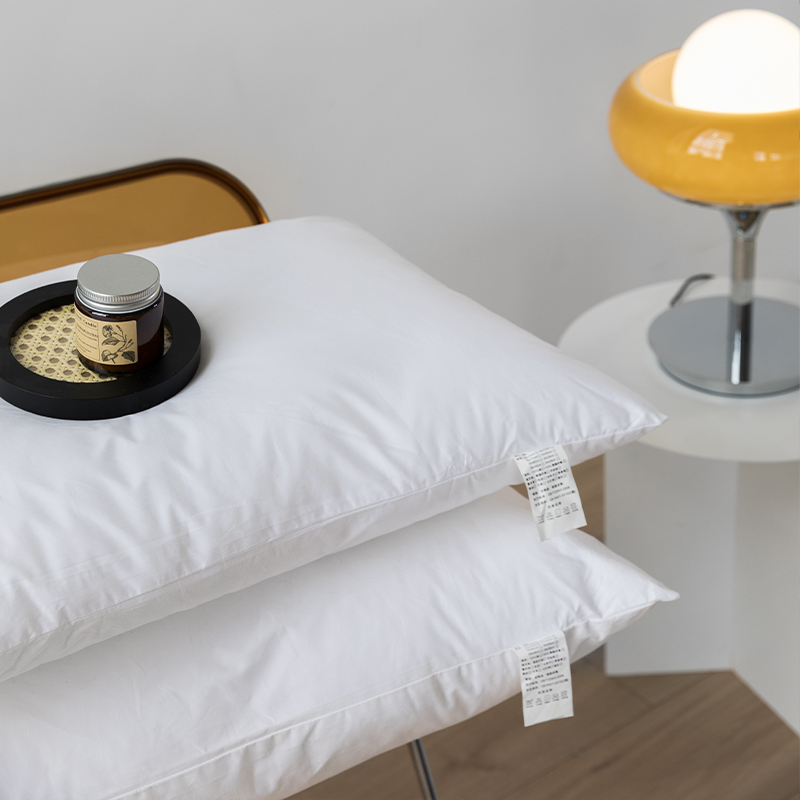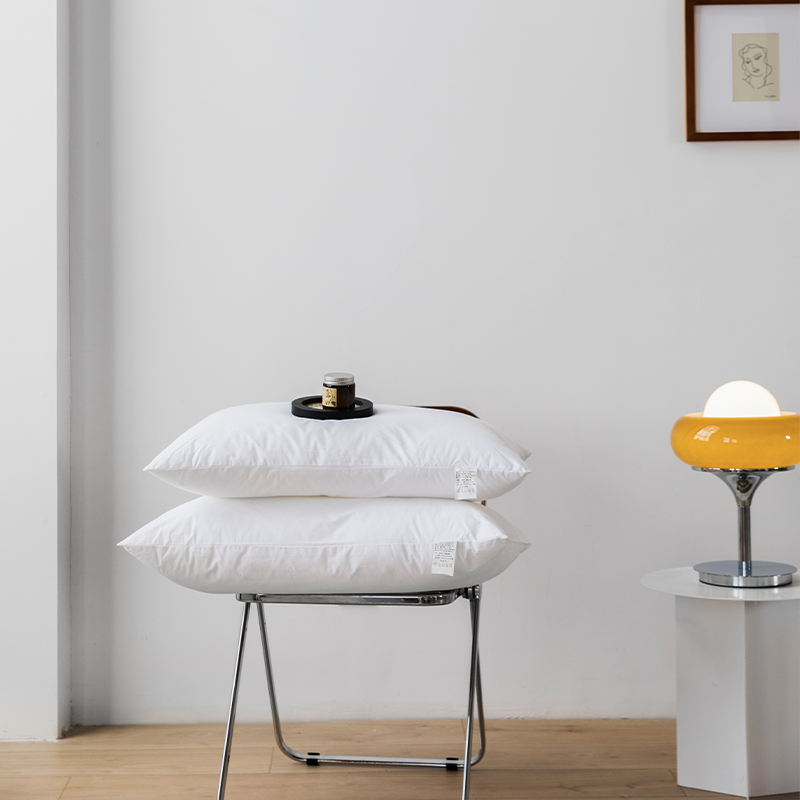Updatetime:2024-06-06 15:21:05 View:
Sleep is an integral part of our daily lives, and a suitable pillow is key to ensuring that we get quality sleep. Pillows not only affect our comfort, but are also closely related to our health. There are a variety of pillows on the market, from materials to designs, and choosing the right one for you can sometimes be confusing. In this article, we will answer some common questions about pillows to help you better understand how to choose and maintain your pillow for the best sleeping experience.

Pillows are crafted from a combination of materials for the outer cover and the stuffing. Common cover fabrics include cotton for breathability, polyester for durability, and silk for luxury. The stuffing can range from natural down and feathers for softness, to synthetic fibers that mimic down, memory foam for contouring support, or even buckwheat hulls for a firm feel. Each material offers different benefits in terms of comfort, support, and temperature regulation.
A pillow insert, also known as a pillow form or stuffing, is the inner material that fills a pillowcase, providing shape, support, and comfort. It can be made from various materials such as polyester fiberfill, down or feather, memory foam, shredded latex, or even natural fillings like buckwheat hulls. Pillow inserts are essential for giving pillows their desired firmness and are often removable for easy washing and maintenance.
A "pillow face" typically refers to the visible part of a pillow that is in direct contact with the user's face when sleeping. This is the side that is usually covered by a pillowcase. The design, texture, and material of the pillow face can affect comfort, support, and the overall sleep experience. Common features of pillow faces include different firmness levels, patterns, and materials like cotton, silk, or memory foam.
A high pillow is one that has a greater elevation from its base to the top, providing more support and lift for the head and neck. High pillows are often preferred by people who sleep on their back or stomach, as they can help maintain proper spinal alignment and prevent strain. They can also be beneficial for side sleepers who need extra support to keep the neck and spine in a neutral position. However, the ideal pillow height can vary depending on personal comfort and sleep position preferences.

Pillows with arms are commonly referred to as "body pillows" or "pregnancy pillows." These pillows are designed to provide extra support and comfort, often used for hugging or propping up different parts of the body, such as the stomach, back, or between the legs. Body pillows are particularly popular among pregnant women to alleviate discomfort during sleep, but they can be used by anyone seeking additional support or a sense of security while sleeping.
Pillows should be replaced every 1 to 3 years, depending on the material. Memory foam pillows last longer, around 3 to 4 years, while polyester pillows may need replacement every 6 months to a year.
Pillows turn yellow primarily due to skin secretions such as sebum and sweat. Sebum, which is naturally secreted by the skin and contains a compound called squalene, can oxidize and cause the pillow to yellow over time. Additionally, the acidic components in sweat can contribute to the yellowing of the pillow. Other factors like saliva and dead skin cells can also play a role in the yellowing process. Men tend to have higher levels of sebum production due to increased androgen levels, which can lead to a higher tendency for their pillows to yellow.
Always check for mold or damage before repurposing; if found, dispose of them properly.
Down pillows generally should not be washed due to the risk of clumping and damage to the down fill. If absolutely necessary, use a large washing machine, cold water, and a gentle cycle with a mild detergent. Always check the care label first.
Check Label: Make sure it's safe to wash your down pillows.
Cold Water: Use a gentle cycle with cold water.
Mild Soap: Choose a mild detergent without bleach or softeners.
Use Balls: Add dryer balls to help the down stay fluffy.
Air Dry: Let pillows dry naturally, fluffing them as they dry.
No Dryer: Avoid using a dryer to prevent damage.
Always follow the care instructions on the pillow's label.
Yes, feather pillows can often be washed, but it's important to follow the care instructions on the label.
Check the Label: Ensure the label says it's machine washable.
Cold Water: Use cold water to protect the feathers.
Gentle Cycle: Select a gentle wash cycle.
Mild Detergent: Use a small amount of mild detergent.
Air Dry: Fully air dry, fluffing the pillow regularly.
No Heat: Avoid using a dryer or direct heat.
Always spot test for colorfastness and check the manufacturer's recommendations.
Yes, bamboo pillows can be washed, but it's important to follow the manufacturer's care instructions. Generally, you can machine wash bamboo pillows on a gentle cycle with cold water and mild detergent. It's also recommended to air dry them, avoiding direct sunlight to prevent damage to the bamboo fibers. Always check the label before washing to ensure the method is suitable for your specific pillow.
Read the Care Label: Check the manufacturer's instructions for any specific care guidelines.
Cold Water: Use cold water to prevent damage to the bamboo fibers.
Gentle Cycle: Select a gentle wash cycle on your washing machine.
Mild Detergent: Use a mild detergent that is free from bleach and fabric softeners.
Air Dry: After washing, air dry the pillow completely, preferably outdoors, and fluff it regularly as it dries.
Avoid Heat: Do not use a dryer or direct heat, as it can damage the pillow.
Sunlight: While sunlight can help to naturally bleach and sanitize, prolonged exposure can fade the color, so be mindful of direct sunlight.
Remember, these are general guidelines and it's always best to follow the specific instructions provided with your bamboo pillow.

Remove the Case: Take off any removable pillowcases.
Prepare a Bath: Fill a basin with lukewarm water and add mild detergent.
Gently Clean: Submerge the pillow and gently scrub.
Rinse: Thoroughly rinse the pillow to remove soap.
Air Dry: Let it dry on a towel in a ventilated area, fluffing it as it dries.
Avoid Sun and Heat: Keep it out of direct sunlight and don't use a dryer.
Check the Label: Look for care instructions on the pillow's label.
Spot Cleaning: For most stains, spot cleaning is sufficient. Use a mild detergent mixed with water.
Hand Wash: If necessary, hand wash the pillow in a bathtub or large sink with mild soap.
Rinse Well: Ensure all soap is thoroughly rinsed from the pillow.
Air Dry: Let the pillow air dry completely. Avoid direct sunlight and heat.
Fluff: Once dry, fluff the pillow to restore its shape.
Always follow the manufacturer's specific cleaning instructions, as they can vary by brand and product.
Avoid putting pillows in the dryer due to potential heat damage, shrinkage, and the risk of mold. Instead, air dry them outdoors or in a well-ventilated area. Always follow the manufacturer's care instructions.
Babies usually don't need pillows until they are 1 year old. Before that, pillows can cause safety issues like SIDS. When they're older and need one, choose a pillow that's the right size and firmness for them.
Now that you have a better understanding of some common issues with our pillows, hopefully you will feel more confident in choosing and using your pillow to ensure a healthy and restorative sleep every night. Remember, a good night's rest is crucial to your overall health and performance in daily life. Choosing the right pillow and maintaining it properly can significantly improve the quality of your sleep and help you wake up feeling refreshed. For more information about pillows, visit our website directly.